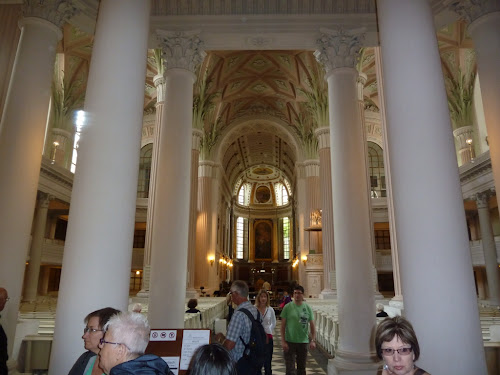We left Wittenberg at 8:30 Saturday morning and headed for Leipzig, an impressive city which has undergone significant changes and improvements in the 24 years since German reunification.
The impressive Hauptbahnhof (train station), second in size only to New York's Grand Central Station
A washroom break at the train station; 1 euro gets you a toilet, 7 euros gets you a shower
Our tour of the city began with St. Thomas Church where Johann Sebastian Bach was the Lutheran Cantor. He was also in charge of the St Thomas School, a kind of musical service institute that had to supply the four major churches in Leipzig with choirs on Sundays and other Christian holidays.
Leipzig University's most famous student, Johann Wolfgang von Goethe, writer of Faust
Just before 12:00 noon, we once again donned our concert dress and sang four songs as part of the Friday noon hour service at the Nikolaikirche (St. Nicholas Church). The church is situated in the very heart of the city, and it seemed strange to be participating in this quiet contemplative service with a bustling shopping and commercial district right outside the doors.
Following three hours of free time (lunch and shopping), we met to hear a presentation by Wilma Sievers, on the Peaceful Revolution, a series of peaceful political protests against the regime of the German Democratic Republic (GDR) of East Germany. Wilma is the wife of a Lutheran pastor and gave a moving account of what life was like for her and her family in the GDR during this time, and how people began to meet to pray for peace.
An article in Der Spiegle describes the events as follows:
By the summer of 1989, East German dissidents had been meeting at Leipzig's 800-year-old Nicolaikirche for almost a decade to pray and talk politics. At times there were fewer than a dozen people in the church, but all through the 1980s the meetings happened every Monday without fail. By the fall of 1989, the prayer meetings had evolved into a nationwide movement centered in Leipzig. And on Oct. 9, Leipzig hosted the largest protest demonstration in East German history: Between 70,000 and 100,000 peaceful demonstrators braved warnings from the feared Stasi, or secret police, and thousands of armed riot cops to march around the city center. In the end, the police did nothing, setting the stage for a peaceful revolution that swept across East Germany.
Wilma's husband, Hans-Jürgen Sievers, has written a book entitled, Stundenbuch einer Deutschen Revolution: Die Leipziger Kirchen im Herbst 1989 (The Story of a German Revolution: The Leipzig Churches in the Autumn of 1989), which unfortunately is not available in English but would be a fascinating read.







Good to hear from you again; enjoying the pictures and your blog. Last day of vacation; back tomorrow (Sunday); doing a 12 hour!
ReplyDeletehey check out the picture taken at Nicolaikirche of the guy wearing the overalls; doesn't he look like Dad?
ReplyDeleteoh I just looked again and realized it's a backpack.
ReplyDelete"By the summer of 1989, East German dissidents had been meeting at Leipzig's 800-year-old Nicolaikirche for almost a decade to pray and talk politics . . . on Oct. 9, Leipzig hosted the largest protest demonstration in East German history: Between 70,000 and 100,000 peaceful demonstrators braved warnings from the feared Stasi, or secret police, and thousands of armed riot cops to march around the city center. In the end, the police did nothing, setting the stage for a peaceful revolution that swept across East Germany."
ReplyDeleteWhat brave & committed people!